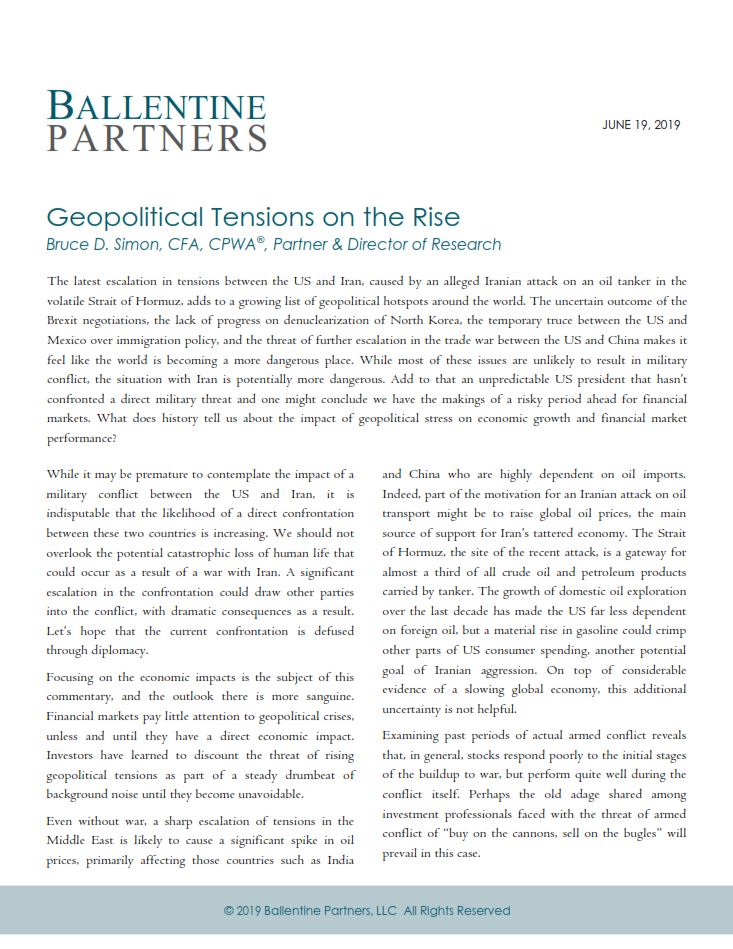 The latest escalation in tensions between the US and Iran, caused by an alleged Iranian attack on an oil tanker in the volatile Strait of Hormuz, adds to a growing list of geopolitical hotspots around the world. The uncertain outcome of the Brexit negotiations, the lack of progress on denuclearization of North Korea, the temporary truce between the US and Mexico over immigration policy, and the threat of further escalation in the trade war between the US and China makes it feel like the world is becoming a more dangerous place. While most of these issues are unlikely to result in military conflict, the situation with Iran is potentially more dangerous. Add to that an unpredictable US president that hasn’t confronted a direct military threat and one might conclude we have the makings of a risky period ahead for financial markets. What does history tell us about the impact of geopolitical stress on economic growth and financial market performance?
The latest escalation in tensions between the US and Iran, caused by an alleged Iranian attack on an oil tanker in the volatile Strait of Hormuz, adds to a growing list of geopolitical hotspots around the world. The uncertain outcome of the Brexit negotiations, the lack of progress on denuclearization of North Korea, the temporary truce between the US and Mexico over immigration policy, and the threat of further escalation in the trade war between the US and China makes it feel like the world is becoming a more dangerous place. While most of these issues are unlikely to result in military conflict, the situation with Iran is potentially more dangerous. Add to that an unpredictable US president that hasn’t confronted a direct military threat and one might conclude we have the makings of a risky period ahead for financial markets. What does history tell us about the impact of geopolitical stress on economic growth and financial market performance?
While it may be premature to contemplate the impact of a military conflict between the US and Iran, it is indisputable that the likelihood of a direct confrontation between these two countries is increasing. We should not overlook the potential catastrophic loss of human life that could occur as a result of a war with Iran. A significant escalation in the confrontation could draw other parties into the conflict, with dramatic consequences as a result. Let’s hope that the current confrontation is defused through diplomacy.
Focusing on the economic impacts is the subject of this commentary, and the outlook there is more sanguine. Financial markets pay little attention to geopolitical crises, unless and until they have a direct economic impact. Investors have learned to discount the threat of rising geopolitical tensions as part of a steady drumbeat of background noise until they become unavoidable.
Even without war, a sharp escalation of tensions in the Middle East is likely to cause a significant spike in oil prices, primarily affecting those countries such as India and China who are highly dependent on oil imports. Indeed, part of the motivation for an Iranian attack on oil transport might be to raise global oil prices, the main source of support for Iran’s tattered economy. The Strait of Hormuz, the site of the recent attack, is a gateway for almost a third of all crude oil and petroleum products carried by tanker. The growth of domestic oil exploration over the last decade has made the US far less dependent on foreign oil, but a material rise in gasoline could crimp other parts of US consumer spending, another potential goal of Iranian aggression. On top of considerable evidence of a slowing global economy, this additional uncertainty is not helpful.
Examining past periods of actual armed conflict reveals that, in general, stocks respond poorly to the initial stages of the buildup to war, but perform quite well during the conflict itself. Perhaps the old adage shared among investment professionals faced with the threat of armed conflict of “buy on the cannons, sell on the bugles” will prevail in this case.
Likely more important to the direction of stock markets is a successful resolution of the trade dispute with China, and by extension, other US trading partners. President Trump seems emboldened by the success of his threat to institute tariffs against Mexico as a way to pressure a change in immigration policy. Despite increasing concern raised by American business leaders about the damaging impact of tariffs, he seems convinced that his China strategy will ultimately bear fruit. The jury is still out.
The recent rally in stock prices, after the sharp selloff in May, is largely based upon the assumption that the Fed will cut interest rates to offset the damaging effects of the trade war. With short-term rates already below long-term averages and long-term rates plumbing the lows last seen in 2017, further declines may pack less economic punch than in past cycles.
In our view, it adds up to a period of heightened volatility in coming months, until some of these issues are resolved. Fortunately, President Trump seems singularly focused on producing strong economic momentum heading into next year’s election, which may be the most important force of all.
Learn more about Bruce Simon, our Director of Research.
This report is the confidential work product of Ballentine Partners. Unauthorized distribution of this material is strictly prohibited.
The information in this report is deemed to be reliable but has not been independently verified. Some of the conclusions in this report are intended to be generalizations. The specific circumstances of an individual’s situation may require advice that is different from that reflected in this report. Furthermore, the advice reflected in this report is based on our opinion, and our opinion may change as new information becomes available.
Nothing in this presentation should be construed as an offer to sell or a solicitation of an offer to buy any securities. You should read the prospectus or offering memo before making any investment. You are solely responsible for any decision to invest in a private offering.
The investment recommendations contained in this document may not prove to be profitable, and the actual performance of any investment may not be as favorable as the expectations that are expressed in this document. There is no guarantee that the past performance of any investment will continue in the future.





